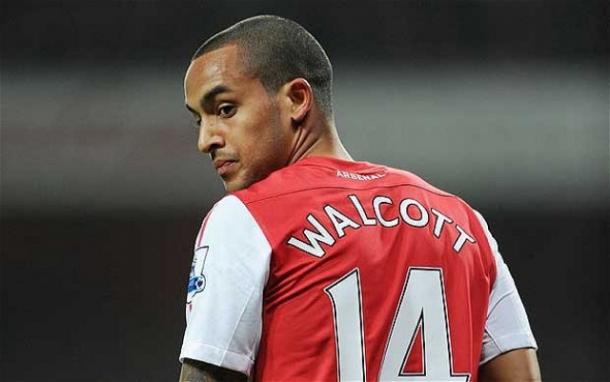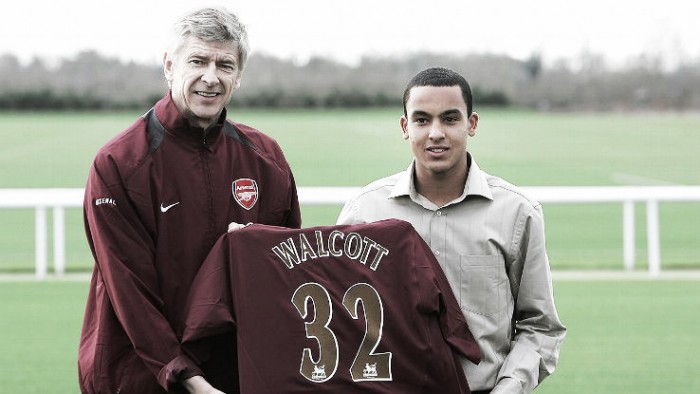When Arsenal signed 16-year-old Theo Walcott from Southampton in 2006 it should have gone one of two ways – either he was going to be an unquantifiable success or an absolute failure and waste of money, instead it’s sort of been in the middle.
The fact Walcott, still only 26, has survived a decade at Arsenal, a club which has seen a huge turnover of players since his arrival shows he can’t be viewed as a failure but the fact he’s never been close to following any of his former teammates to teams like FC Barcelona or Manchester City is perhaps an indictment of how limited he is.
Inconsistent
Walcott’s problem has always been consistency; ever since getting a regular berth in the first team he’s either dazzled defences or infuriated supporters, several years ago it was put down to inexperience but now a seasoned professional it’s sadly just how he is.
Perhaps his early years didn’t help, his flashes of brilliance, including an amazing run at Anfield where he beat several Liverpool defenders to set up Emmanuel Adebayor and seemingly put Arsenal into the UEFA Champions League semi-final, kept the hype rolling on a player still finding his feet. The hype was already rolling from his surprising call-up to England’s 2006 FIFA World Cup squad despite being only signed by the Gunners in January and yet to play for his new club.
He’d only scored five goals in 23 games for Southampton in the Championship that season before moving. The call-up was one of Sven Goran Eriksson’s last crazy acts before stepping down as England manager, the problem was he’d put the spotlight on Walcott and the youngster never quite lived up to it.
However, England’s most expensive 16-year-old at the time did start the following season and the key was to develop Walcott ready to be a focal point of the next World Cup.
Development came; a goal in the League Cup final in 2007 was his first for Arsenal, the assist at Anfield previously mentioned showed how dangerous Walcott could be but still he remained an impact player. His use as a change-of-pace substitute made it as far as sitcoms, with an exchange between a one-off postman and football illiterate Moss in Channel 4’s The IT Crowd including: “What was Wenger thinking putting Walcott on that early?”
It was a reputation that stuck with Walcott until recently; well you have to leave him on the bench for the last twenty minutes when the game opens up.
The reputation comes of course from the forward’s exemplary speed which immediately drew comparisons to Arsenal legend Thierry Henry and was made worse when following Henry’s departure to FC Barcelona, Walcott would take up the Frenchman’s fabled ‘14’ shirt.

Henry replacement
Given Wenger’s ability to convert Henry, a misused winger at Juventus into one of the greatest strikers England’s ever seen, there was belief that the same would happen for Walcott and throughout his Arsenal career pundits have been waiting for his conversion to centre forward.
Former Arsenal defender Martin Keown, analysing on Match of the Day was so desperate to see it happen, he claimed Walcott’s age being close to Henry’s when the Frenchman signed should be reason enough that he should be moved.
“Well Henry was 23 when he was moved to striker and Walcott is now 23 too.”
Following the recent ineffective performance out wide against Stoke City from Walcott and his displays in the FA Cup final and earlier this season many have now summarised that Walcott is best suited as a centre-forward but Thierry Henry he is not.
Although he can get in behind and beat almost any defender for pace and has a knack for a good finish, Walcott is missing every other attribute to succeed in the same position. He hasn’t the same amount of ball control and trickery as Henry, the Frenchman once made Jamie Carragher fall into his own defender by running at him, Walcott would be more likely to fall over the ball and for every chance he sticks away quickly, he misses three easy one-on-ones that he has time to think about.
It’s the reason he’s perhaps the most infuriating player Arsenal may ever have had, for all the promise, all the physical attributes and all the flashes of absolute brilliance, he’s never quite made the level everyone thought he would.
Still, you can’t say he’s been a failure, in fact, compared to the rest of the infamous Daily Mail future England squad predicted in 2007, he’s one of three still in the Premier League and the other two are Scott Sinclair and Micah Richards, both likely to be relegated with Aston Villa this season.
He’s also probably the most prolific of his style of player, a quick wide player who’s not good enough down the middle but not the best out wide either, in terms of development, he’s arguably far superior to Aaron Lennon and Shaun Wright-Phillips that came before him but when he signed in 2006, we expected more.
Walcott will probably be in the Arsenal squad for another decade with another host of coaches not quite sure what to do with him. Do we start him? Do we give him half hour? Out wide? Or up front on his own? It remains to be seen.










































